What is the asthenosphere?
The interior of the earth has differentiated into different layers, roughly into the earth's core, earth's mantle and earth's crust. The asthenosphere is part of the upper mantle.

The interior of the earth - still largely unknown
- Of course, nobody knows what the interior of the earth really looks like, because even boreholes in which rock samples are drawn up only lead a few kilometers into the depths. Nevertheless, geoscientists have succeeded in gaining insights into the interior of the earth, which is inaccessible to humans, for example "by listening to" seismic waves (earthquake waves).
- The core of the finding is that the earth has a kind of peel or layer structure, similar to an onion. One can roughly distinguish the core of the earth, the earth's mantle and the earth's crust from the inside out.
- The earth's core is liquid, a solid center in it is assumed, which consists of an iron-nickel compound. Outside of this core everything is "stone", although this should not necessarily be thought of as solid.
- Rocks in the earth's mantle, which flow there under very high pressure and at high temperatures, are brought up by plate tectonics from a depth of more than 100 kilometers. However, the speed is slow, it is only a few centimeters per year.
- In contrast to the earth's core and mantle, the (outer) earth's crust is surprisingly thin, namely an average of 70 kilometers under the continents and often only 10 kilometers thick under the oceans. It belongs to the so-called lithosphere, the solid rock layer of the earth.
Layers of the earth - the interior of the earth
People have always been fascinated by what the interior of the earth might look like. …
The asthenosphere is part of the earth's mantle
- Of course, this division is only rough - the individual layers are by no means homogeneous and are further divided in the geosciences.
- The asthenosphere, also known as the flow zone, comprises the upper part of the earth's mantle. It occupies a depth of 100 to 250 kilometers in the shell structure of the earth and is practically the first layer under the rigid lithosphere. In the model, the lithosphere "floats" on this hotter and therefore softer layer - this layer is therefore responsible for the movement of the lithospheric plates. It is also used to feed volcanoes and hotspots.
- As so often in the sciences, the term asthenosphere comes from the Greek. So "a - sthenos" in German means "without firmness".
How helpful do you find this article?


